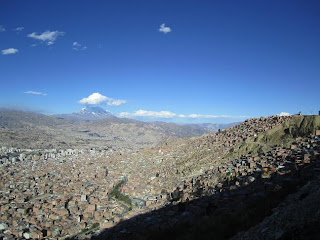Lake Titicaca is the highest lake in the world. It's altitude is about 3800 meters above sea level and it's part of Peru as well as Bolivia. "Titi" means "puma" and "caca" means "rock" in the Quechua language. We learned that on a trip to the the Isla Amantani where we spent the night with a native host family. It was a very fun experience. Especially playing with paper airplanes with the 10 year old boy "Jimmy" who speaks Spanish really well. At home the family speaks Quechua together, but kids learn Spanish in school from an early age.
Jimmy and us in the host family's small kitchen.
Our hosts Gustina and Nicolas made us feel very welcome in their adobe home. Gustina is a certified cook and made delicious meals. Lots of carbs and all local ingredients like quinoa, fresh cow cheese patties and Oca (little sweet patatoes that we nicknamed Poopatatoes). I really liked the Muna tea, similar to a mint tea and it's supposed to help with high altitude.
Sunset from the top of the hill behind the village.
Young girls trying to sell their hand made bracelets to Semu.
Dressed up for the fiesta with the locals of the Occopampa community. It is one of 10 communities on Amantani Island. The integrating tourism project we were part of chooses host families by rotation, so all the different families and communities get the same opportunity of hosting international guests.
We also got to visit Isla Taquile, another island inhabited by Quechuan people. The natives still wear their traditional clothing every day which is very colorful.
Taquile Island
Celebration for 80 years of education. Those kids were super cute.
FLOATING ISLANDS
There are floating islands on the Titicaca Lake made out of reeds. Reeds are a long grassy material and very spongy to walk on. The islands are about 2 meters thick, half reed grass and half reed roots with dirt.
A bunch of reeds in front of a reed house on Q'otomarca, one of the floating islands.
Local taxi for island hopping. The boat is also made out of reeds. This is an older one, fresher ones aren't so saggy at the ends.
Another type of reed boat. Not sure how sturdy it is.
ISLA DEL SOL
Isla del Sol is a few hours by boat from Copacabana on the Bolivian side of Titicaca Lake. There are some Inca ruins on the Island as well. We walked along the ridge of the island from the northern port to the southern port. The walk was really nice and the scenery beautiful.
View over the bay and the snowy mountain tops from Isla del Sol.
Donkeys carrying water supplies.
COPACABANA
A quiet little town on the Bolivian side of the Lake. It's much nicer than Puno, the town we stayed in on the Peruvian side of the Lake.

All kinds of different popped grains in huge bags. I've never seen big old popcorn like that!
Crossing the Lake at a narrower part on our way to La Paz.



















































